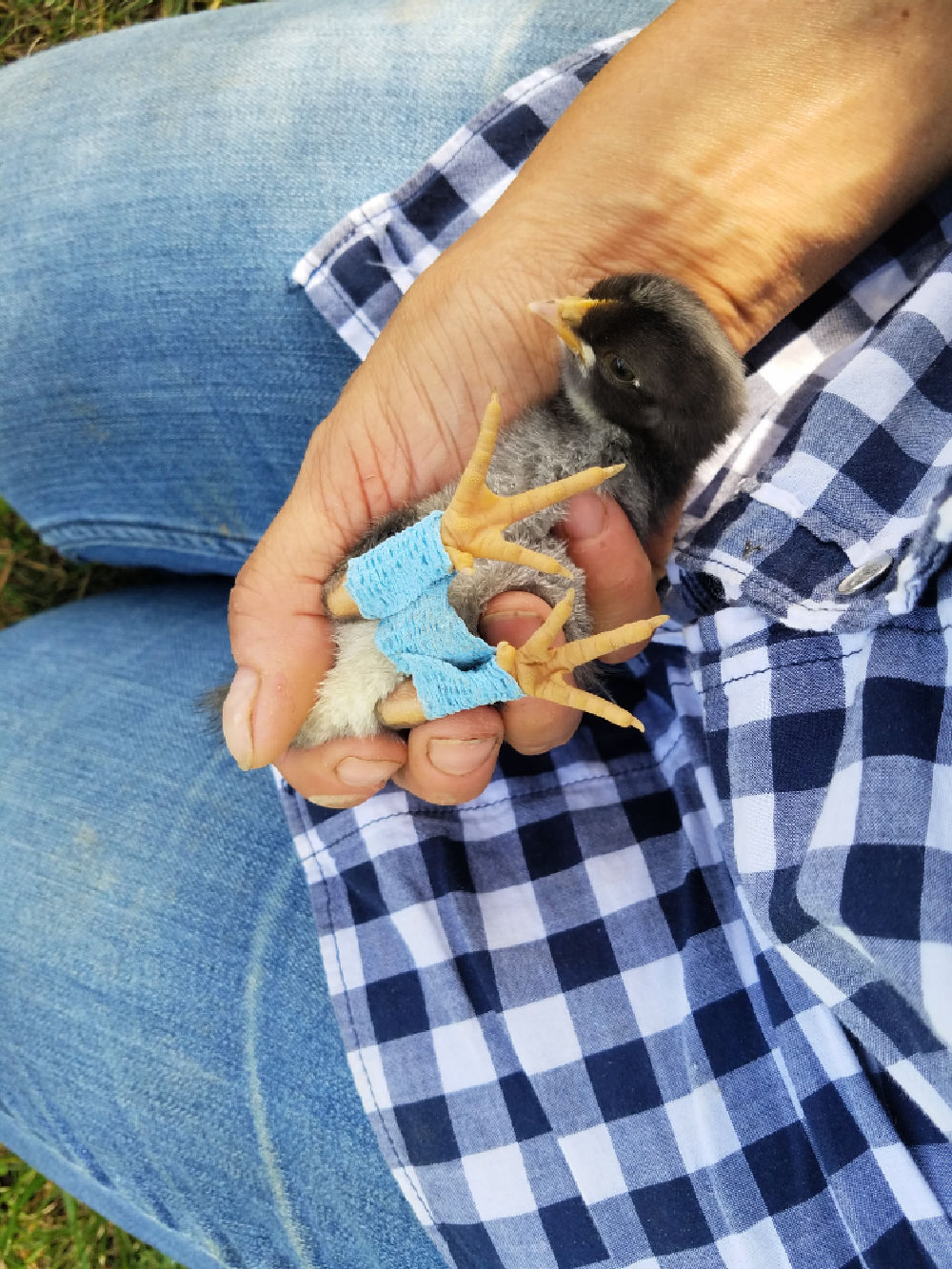It is too late to fix a splayed leg once the chick reaches 2 to 3 weeks of age. A splayed leg is a condition where a chick’s legs are positioned outwards instead of being straight, making it difficult for them to walk or stand.
Fixing a splayed leg requires immediate attention and intervention within the first week of the chick’s life. The most common method to correct a splayed leg is through the use of leg splints or braces. These devices help to align the chick’s legs in the proper position, allowing the leg muscles to develop correctly.
However, once the chick grows older, its leg bones harden, making it difficult to reposition the legs effectively. Therefore, it is crucial to address splayed legs as early as possible to increase the chances of successful correction.
The Causes Of Splayed Leg In Birds
Developmental issues during incubation, nutritional deficiencies, and genetic predisposition can all contribute to a condition known as splayed leg in birds. Splayed leg occurs when a bird’s legs grow outward instead of remaining in a normal position. This can lead to difficulty in walking, perching, and maintaining proper balance.
During incubation, improper positioning of the eggs or improper temperature and humidity levels can disrupt the leg development of the growing chick. Nutritional deficiencies, particularly in vitamins and minerals like niacin, riboflavin, and biotin, can also lead to weak bones and muscles, increasing the likelihood of splayed leg.
Genetic predisposition is another factor that can predispose certain bird species or breeds to splayed leg. Some birds may inherit structural abnormalities or weaknesses in their legs, making them more susceptible to developing splayed leg.
Recognizing The Symptoms Of Splayed Leg
- Abnormal leg posture or position: One of the most prominent symptoms of splayed leg in birds is an abnormal leg posture or position. Affected birds may have legs that splay out to the side, forming a V shape, or they may be unable to keep their legs underneath their body.
- Difficulty standing or walking: Another sign to look for is difficulty standing or walking. Birds with splayed leg may struggle to support their weight on their legs or have trouble maintaining balance while walking.
- Inability to balance properly: Additionally, birds with splayed leg may demonstrate an inability to balance properly. They may have difficulty perching or maintaining equilibrium on uneven surfaces.
The Importance Of Early Intervention
Early intervention is crucial for fixing a splayed leg in animals. Acting promptly can prevent further complications and increase the chances of successful treatment.
When it comes to splayed leg in animals, early intervention is crucial for successful treatment. Prompt veterinary assessment and diagnosis are key to determining the underlying cause and developing an appropriate treatment plan. It is never too early to seek professional help; the sooner the issue is addressed, the better the chances of a positive outcome.
Veterinarians may recommend splinting or bandaging the affected legs to provide support and alignment. This helps correct the leg deformity and allows for proper healing. Additionally, controlled exercises and physical therapy may be prescribed to strengthen the leg muscles and improve coordination.
By addressing splayed leg early on, pet owners can potentially avoid the need for more invasive and costly interventions down the line. Remember, the earlier the intervention, the better the prognosis for a full recovery.
Factors That Affect The Success Of Treatment
The success of treatment for splayed leg depends on several factors, including the age of the bird at the time of intervention, the severity of the splayed leg condition, and compliance with treatment protocols.
| Age of the bird at the time of intervention | Severity of the splayed leg condition | Compliance with treatment protocols |
| Younger birds have a higher chance of successful treatment as their bones and joints are still developing and more responsive to corrective measures. | Mild cases of splayed leg are easier to correct compared to severe cases where the bones may have become permanently misaligned. | Strict adherence to treatment protocols, including consistent use of splints or bandages, can improve the chances of successful outcomes. |
Early intervention is crucial, but even older birds or more severe cases can still see improvement with proper care and treatment. Regular monitoring and adjustments to the treatment plan may be necessary to optimize the chances of successful correction.
Potential Complications And Consequences
Fixing a splayed leg becomes more challenging as time goes on, with potential complications and consequences increasing. It’s crucial to address this condition promptly to improve the chances of successful treatment.
| Potential Complications and Consequences: |
|

Credit: www.wired.com
When Is It Too Late To Fix A Splayed Leg: Crucial Time Constraints
Early intervention is crucial when it comes to treating a splayed leg in birds. The earlier the problem is identified, the better the chances of successful correction. However, there are some challenges involved in treating older birds with a splayed leg.
For breeders and owners, the decision to address the issue may depend on various factors. One consideration is the age of the bird. Older birds may have already developed habits and compensatory mechanisms that make treatment more challenging.
Another important factor to consider is the severity of the splayed leg. Severe cases may require more invasive procedures or have a lower success rate. Partial or temporary correction may be a viable option for less severe cases in older birds.
| Importance of early intervention | Challenges of treating older birds | Decision-making considerations for breeders and owners |
|---|---|---|
| Better chances of successful correction if addressed early | Compensatory mechanisms may hinder treatment | Age of the bird impacts decision to address |
| Prevention of complications in the long run | More invasive procedures may be necessary | Severity of the splayed leg influences the approach |
| Easier adjustment to corrective measures | Partial or temporary correction may be an option |
Consultation With Avian Specialists
When confronting a splayed leg in birds, seeking advice from avian specialists is crucial for appropriate management. These professionals possess the necessary expertise and experience required to assess the severity of the condition and recommend suitable treatment options. Proper consultation helps in understanding the limitations associated with each available treatment alternative. Whether it’s a case of simple leg bandaging or utilization of splints, seeking expert opinions ensures accurate diagnosis and effective guidance for the best possible approach.
By consulting avian specialists, one can gain insight into the challenges and potential outcomes associated with treating splayed leg. In some cases, alternative management strategies such as physical therapy or accommodations in the bird’s environment might be explored. Finding knowledgeable professionals who specialize in avian medicine is crucial to ensure the bird’s well-being and increase the chances of successful treatment.
Preventing Splayed Leg In Birds
Proper nutrition during incubation plays a crucial role in preventing splayed leg in birds. Ensuring that the parent birds receive a balanced diet rich in essential nutrients, vitamins, and minerals can significantly reduce the risk of splayed leg in their offspring. Monitoring brooding conditions is equally important to prevent this condition. Providing a clean and comfortable brooding environment with sufficient warmth and appropriate humidity levels can promote healthy leg development. Additionally, minimizing genetic complications involves careful breeding practices. Breeders should consider the genetics of the parent birds, avoiding crossing individuals with known leg deformities or weaknesses.
Maintaining optimal nutrition during incubation, monitoring brooding conditions, and minimizing genetic complications are key strategies for preventing splayed leg in birds. By following these precautions, bird owners and breeders can ensure healthier legs and overall well-being in their feathered friends.
Frequently Asked Questions On When Is It Too Late To Fix A Splayed Leg
How Do You Fix A Splay Leg In An Older Chick?
To fix a splay leg in an older chick, you can use splints or bandages to gently realign the legs. Make sure the chick has a supportive and comfortable surface to stand on, like a towel. Consult a veterinarian for proper guidance and care.
How Long Does It Take Splayed Leg To Heal?
Splayed leg healing time varies, but with proper treatment, it can take around 2-4 weeks. Adequate splinting, frequent leg exercises, and orthopedic support can help speed up the recovery process. Consult a veterinarian for a specific timeframe based on your pet’s condition.
Can Splayed Leg Fix Itself?
Splayed leg in chicks can be fixed with proper treatment. It involves providing support and correcting the leg position. With timely intervention and care, the condition can improve and the chick can regain normal leg function.
Can A Chicken Live With Spraddle Leg?
Yes, a chicken can live with spraddle leg, but it may face challenges with walking and balancing. It’s important to provide proper care and support, like splinting the legs, to help the chicken thrive.
Conclusion
Addressing a splayed leg in birds as early as possible is crucial to increase the chances of successful correction. Ignoring or delaying treatment can result in long-term deformities that might be irreversible. Consulting a veterinarian or an avian specialist is recommended to determine the appropriate intervention for each individual case.
Remember, early intervention is key when it comes to fixing a splayed leg in birds.

Hridoy, a dedicated pigeon enthusiast, is known for his deep affection for these feathered creatures. His passion for pigeons is evident in the way he cares for and cherishes them. From meticulously maintaining pigeon coops to studying their behavior, Hridoy’s love for these birds knows no bounds.
